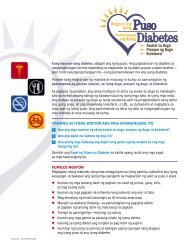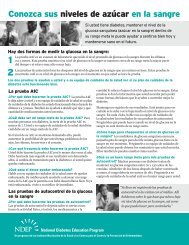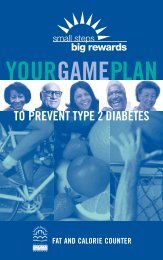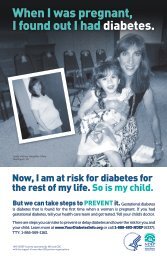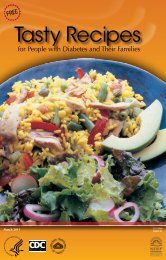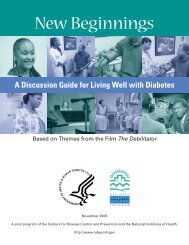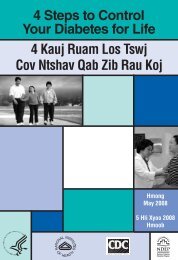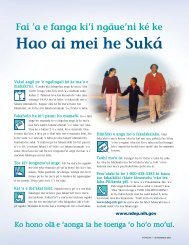Power to Prevent - National Diabetes Education Program - National ...
Power to Prevent - National Diabetes Education Program - National ...
Power to Prevent - National Diabetes Education Program - National ...
Create successful ePaper yourself
Turn your PDF publications into a flip-book with our unique Google optimized e-Paper software.
Say: “The objectives for <strong>to</strong>day’s session are for us <strong>to</strong>:<br />
Describe the goals of this program, which is called <strong>Power</strong> <strong>to</strong> <strong>Prevent</strong><br />
Discuss the impact that small steps can make in preventing or delaying getting diabetes and in<br />
controlling diabetes<br />
Use <strong>to</strong>ols <strong>to</strong> help take small steps in food choices and in physical activity levels<br />
In future sessions, we’ll learn behavioral changes that can help prevent, delay, or control diabetes. In this session<br />
we’ll spend time learning about <strong>to</strong>ols that we can use <strong>to</strong> help us make changes in eating and in physical activity<br />
levels.”<br />
Refer <strong>to</strong> the fipchart that lists the session titles, and give a brief overview of the <strong>to</strong>pics that will be<br />
covered in future sessions. Display this fipchart during all 2 sessions.<br />
Discussion Points<br />
Introduce the following questions during the discussion:<br />
What is diabetes?<br />
What are some of the complications of diabetes?<br />
Who is at high risk for diabetes?<br />
What can I do <strong>to</strong> reduce my risk?<br />
NOTE: Understanding diabetes is a huge <strong>to</strong>pic. All you can give in this frst session is a very basic overview <strong>to</strong><br />
help people understand why preventing diabetes is so important. Some participants may have signed up for the<br />
program <strong>to</strong> learn more specifcally about diabetes. An optional session (Session 6: <strong>Diabetes</strong> Overview, Parts 1–3)<br />
can be held <strong>to</strong> give participants some background on diabetes. However, the sessions in this program CANNOT<br />
replace diabetes education classes. The purpose of the <strong>Power</strong> <strong>to</strong> <strong>Prevent</strong> program is specifcally <strong>to</strong> impart healthy<br />
eating and physical activity habits.<br />
What is <strong>Diabetes</strong>?<br />
Say: “<strong>Diabetes</strong> is a disease in which the body does not produce insulin or doesn’t use it properly. Insulin<br />
is a hormone made by a gland called the pancreas. When a person digests food, glucose (or sugar) is<br />
produced as a basic fuel for the cells of the body. The purpose of insulin is <strong>to</strong> help the glucose move<br />
from the blood in<strong>to</strong> the cells.<br />
When a person without diabetes digests food, the pancreas produces the right amount of insulin <strong>to</strong><br />
move glucose from the blood in<strong>to</strong> the cells. In people with diabetes, however, either the pancreas<br />
produces little or no insulin, or the cells don’t respond <strong>to</strong> the insulin that’s produced. So glucose<br />
can’t get in<strong>to</strong> the cells, and it builds up in the blood. A person’s blood glucose level then becomes<br />
<strong>to</strong>o high, and the result is pre-diabetes or diabetes.<br />
There is no single cause of diabetes; many fac<strong>to</strong>rs play a role. There are several different types of<br />
diabetes.”<br />
NDEP <strong>Power</strong> <strong>to</strong> <strong>Prevent</strong> Session 4



